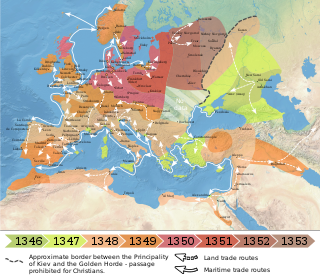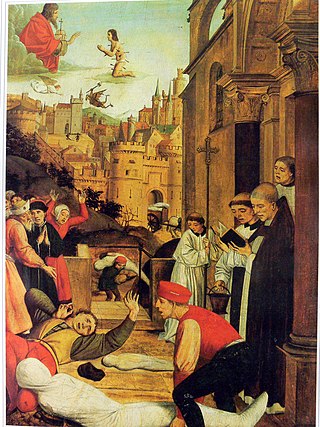
The Plague is a 1947 absurdist novel by Albert Camus. It tells the story from the point of view of a narrator in the midst of a plague sweeping the French Algerian city of Oran. The narrator remains unknown until the beginning of the last chapter. The novel presents a snapshot into life in Oran as seen through the author's distinctive absurdist point of view.

The Black Death was a bubonic plague pandemic occurring in Europe from 1346 to 1353. It was one of the most fatal pandemics in human history; as many as 50 million people perished, perhaps 50% of Europe's 14th century population. The disease is caused by the bacterium Yersinia pestis and spread by fleas and through the air. One of the most significant events in European history, the Black Death had far-reaching population, economic, and cultural impacts. It was the beginning of the second plague pandemic. The plague created religious, social and economic upheavals, with profound effects on the course of European history.

A pandemic is an epidemic of an infectious disease that has spread across a large region, for instance multiple continents or worldwide, affecting a substantial number of individuals. Widespread endemic diseases with a stable number of infected individuals such as recurrences of seasonal influenza are generally excluded as they occur simultaneously in large regions of the globe rather than being spread worldwide.

A zoonosis or zoonotic disease is an infectious disease of humans caused by a pathogen that can jump from a non-human to a human and vice versa.

An epidemic is the rapid spread of disease to a large number of hosts in a given population within a short period of time. For example, in meningococcal infections, an attack rate in excess of 15 cases per 100,000 people for two consecutive weeks is considered an epidemic.

Gaëtan Dugas was a Québécois Canadian flight attendant whose role in the early years of the AIDS epidemic attracted considerable attention. Initially identified as a central figure labeled "Patient Zero" Dugas faced allegations of being a primary source of HIV transmission to the United States. This narrative, popularized notably by Randy Shilts' 1987 book And the Band Played On, has been refuted through subsequent scientific scrutiny and historical re-evaluation. Dugas' story highlights the perils of misinformation and the stigma surrounding HIV/AIDS in the 1980s. Despite facing criticism in popular discourse, subsequent studies have provided a more nuanced understanding of Dugas' impact on the epidemic, emphasizing the importance of accuracy and empathy in public health narratives.

A Journal of the Plague Year: Being Observations or Memorials, Of the most Remarkable Occurrences, As well Publick as Private, which happened in London During the last Great Visitation In 1665, commonly called A Journal of the Plague Year, is a book by Daniel Defoe, first published in March 1722. It is an account of one man's experiences of the year 1665, in which the bubonic plague struck the city of London in what became known as the Great Plague of London, the last epidemic of plague in that city. The book is told somewhat chronologically, though without sections or chapter headings, and with frequent digressions and repetitions.

The plague of Justinian or Justinianic plague was an epidemic that afflicted the entire Mediterranean Basin, Europe, and the Near East, severely affecting the Sasanian Empire and the Byzantine Empire, especially Constantinople. The plague is named for the Byzantine Emperor Justinian I, who according to his court historian Procopius contracted the disease and recovered in 542, at the height of the epidemic which killed about a fifth of the population in the imperial capital. The contagion arrived in Roman Egypt in 541, spread around the Mediterranean Sea until 544, and persisted in Northern Europe and the Arabian Peninsula until 549. By 543, the plague had spread to every corner of the empire. As the first episode of the first plague pandemic, it had profound economic, social, and political effects across Europe and the Near East and cultural and religious impact on Eastern Roman society.

The third plague pandemic was a major bubonic plague pandemic that began in Yunnan, China, in 1855. This episode of bubonic plague spread to all inhabited continents, and ultimately led to more than 12 million deaths in India and China, and at least 10 million Indians were killed in British Raj India alone, making it one of the deadliest pandemics in history. According to the World Health Organization, the pandemic was considered active until 1960 when worldwide casualties dropped to 200 per year. Plague deaths have continued at a lower level for every year since.

The Great Plague of Marseille, also known as the Plague of Provence, was the last major outbreak of bubonic plague in Western Europe. Arriving in Marseille, France, in 1720, the disease killed over 100,000 people: 50,000 in the city during the next two years and another 50,000 to the north in surrounding provinces and towns.
Donald Pinkston Francis is an American epidemiologist who worked on the Ebola outbreak in Africa in the late 1970s, and as an HIV/AIDS researcher. He retired from the U.S. Public Health Service in 1992, after 21 years of service. He lives in San Francisco, California.
An infection is the detrimental colonization of a host organism by a foreign species.
The index case or patient zero is the first documented patient in a disease epidemic within a population, or the first documented patient included in an epidemiological study. It can also refer to the first case of a condition or syndrome to be described in the medical literature, whether or not the patient is thought to be the first person affected. An index case can achieve the status of a "classic" case study in the literature, as did Phineas Gage, the first known person to exhibit a definitive personality change as a result of a brain injury.
Globalization, the flow of information, goods, capital, and people across political and geographic boundaries, allows infectious diseases to rapidly spread around the world, while also allowing the alleviation of factors such as hunger and poverty, which are key determinants of global health. The spread of diseases across wide geographic scales has increased through history. Early diseases that spread from Asia to Europe were bubonic plague, influenza of various types, and similar infectious diseases.
An epidemic is a disease that spreads rapidly.

Bubonic plague is one of three types of plague caused by the bacterium Yersinia pestis. One to seven days after exposure to the bacteria, flu-like symptoms develop. These symptoms include fever, headaches, and vomiting, as well as swollen and painful lymph nodes occurring in the area closest to where the bacteria entered the skin. Acral necrosis, the dark discoloration of skin, is another symptom. Occasionally, swollen lymph nodes, known as "buboes", may break open.
The first plague pandemic was the first historically recorded Old World pandemic of plague, the contagious disease caused by the bacterium Yersinia pestis. Also called the early medieval pandemic, it began with the Plague of Justinian in 541 and continued until 750 or 767; at least fifteen or eighteen major waves of plague following the Justinianic plague have been identified from historical records. The pandemic affected the Mediterranean Basin most severely and most frequently, but also infected the Near East and Northern Europe, and potentially East Asia as well. The Roman emperor Justinian I's name is sometimes applied to the whole series of plague epidemics in late Antiquity.

The second plague pandemic was a major series of epidemics of plague that started with the Black Death, which reached medieval Europe in 1346 and killed up to half of the population of Eurasia in the next four years. It followed the first plague pandemic that began in the 6th century with the Plague of Justinian, but had ended in the 8th century. Although the plague died out in most places, it became endemic and recurred regularly. A series of major epidemics occurred in the late 17th century, and the disease recurred in some places until the late 18th century or the early 19th century. After this, a new strain of the bacterium gave rise to the third plague pandemic, which started in Asia around the mid-19th century.

The 1899 Porto plague outbreak was an epidemic of bubonic plague centered in the city of Porto, in the north of Portugal.












